Streamline Operations with the Best Queue Management Software Solutions
Introduction: The True Cost of Waiting in Line
In today's dynamic environment, managing customer queues efficiently is more crucial than ever for small businesses. Long waits and disorganized crowd management can significantly hamper customer satisfaction and operational performance. Queue management software provides an innovative approach to streamline operations, ensuring seamless interactions for both customers and businesses.. This is where QueueAway’s management system software steps in—not as a luxury, but as a business necessity.
Whether you're in healthcare, retail, banking, education, or government services, effective queue management is directly linked to customer satisfaction. Long wait times remain one of the most common complaints across industries, yet studies show that businesses equipped with digital queue management solutions consistently outperform their competitors.
🔍 Statistic: According to a report by NewVoiceMedia, poor customer service—often caused by unmanaged queues—costs U.S. businesses an estimated $75 billion annually.
This blog is your comprehensive, data-rich guide to queue management system software: what it is, how it works, why it matters, and how it’s shaping customer experiences in 2025 and beyond. Designed for decision-makers, IT managers, and customer experience professionals, this guide includes:
Expert-backed statistics
Real-world use cases
Future trends
Best practices and evaluation tips
Data-driven businesses outperform competitors by a wide margin… McKinsey – The Age of Analytics
This article examines the essential features that make queue management software vital, including virtual queuing, appointment scheduling, real-time updates, and self-service check-ins. By adopting these solutions, organizations can enhance the customer experience, reduce wait times, and optimize operational efficiency.
We'll explore how various industries like healthcare, retail, and banking leverage these systems and offer insights into selecting the right software. Additionally, we will highlight leading options on the market, compare free and paid solutions, and discuss emerging trends in queue management technology.
Let’s explore how smart queuing is becoming a cornerstone of efficient service—and how your business can stay ahead of the curve.
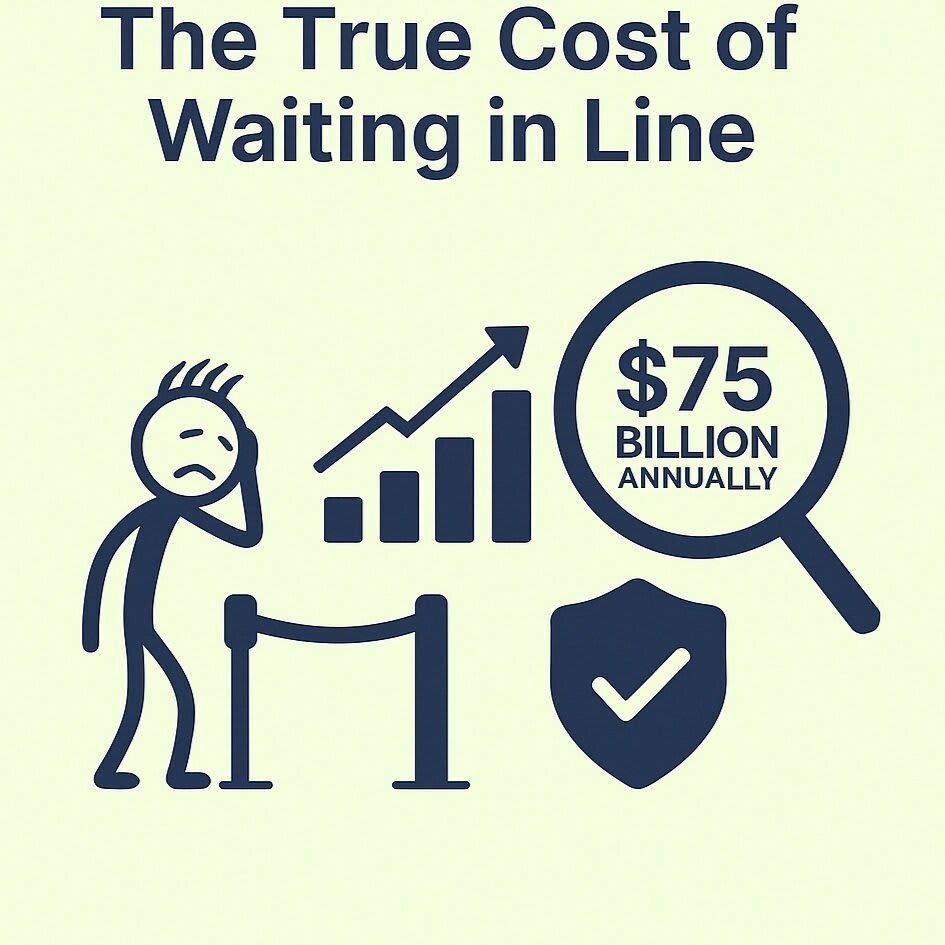
The True Cost of Waiting in Line – Queue Management System Software by QueueAway
This visual illustrates how unmanaged queues impact business revenue, costing U.S. companies $75 billion annually—reinforcing the necessity of queue management system software like QueueAway to enhance efficiency and customer experience.
What Is Queue Management System Software?
Queue management system software is a digital solution designed to streamline and organize the customer journey by managing wait lines—virtual or physical—in a structured and efficient manner. These systems help businesses minimize customer wait times, maximize staff efficiency, and improve the overall service experience.
Long wait times lead to queue abandonment and lost revenue…
There are three primary types of queue management systems:
Physical Queue Management Systems – Traditional token-based or ticket-based systems.
Virtual Queue Management Systems – Allow customers to join queues remotely via mobile apps, web links, or kiosks.
Hybrid Systems – Combine physical and virtual elements, offering the most flexible experience.
Mobile-first platforms are transforming customer expectations in real time… Statista – Mobile usage trends
Key Features of Queue Management Software
Queue management software is a powerful tool designed to optimize and streamline the customer flow experience. It offers a scalable and flexible solution that evolves alongside business needs, ensuring cost efficiency and operational scalability, especially as businesses expand to new locations. The software provides real-time customer data and operational insights, empowering businesses to optimize staffing, eliminate bottlenecks, and enhance customer experiences. Highly configurable, it allows businesses to tailor solutions without vendor intervention, thus boosting customer engagement and satisfaction. By integrating advanced analytics and reporting tools, queue management software enables organizations to collect and analyze performance data, facilitating continuous improvement and informed, data-driven decisions. Automation, including host alert notifications and post-visit communication, further increases operational efficiency by reducing manual tasks and helping gather valuable customer feedback.
Virtual Queuing
Virtual queuing revolutionizes the waiting experience by allowing customers to join a queue without physically standing in line. This flexibility offers customers the choice to wait wherever they prefer. The system supports several check-in methods, such as QR codes, SMS, WhatsApp, on-site tablets, or kiosks, enhancing accessibility. Customers receive real-time notifications about their queue position, improving the waiting experience by keeping them informed. Staff can efficiently view and manage customer queues via any web browser-supported device, ensuring robust service interfaces. Virtual queuing solutions also include features like automated notifications and appointment scheduling, which help balance customer flow and reduce congestion in service lines.
Appointment Scheduling
Appointment scheduling integrated with queue management systems simplifies the booking process and reduces administrative burdens. Patients, for instance, can make online bookings and receive confirmations and reminders, streamlining the healthcare staff's workload. This system is applicable to various departments, including registrars and information desks, where appointment tracking and insights are crucial. Public check-in systems and real-time updates offered by some queue management solutions ensure efficient visitor management, accommodating high-traffic areas by blending digital queuing with appointment solutions. These cloud-based platforms provide functionalities such as online waitlists, reminders, and management dashboards, enhancing customer intake processes and contributing to shorter wait times.
Real-Time Updates
Real-time updates are a crucial component of queue management systems, providing transparency and enhancing the customer waiting experience. Customers receive continuous information about their queue position and estimated wait time through SMS, email, or mobile notifications, allowing them to manage their time effectively. This real-time communication adds a human touch, which fosters better customer engagement and satisfaction. An online queue page can also keep customers informed about changes in services or product statuses, leading to an improved waiting experience. Additionally, real-time data capture allows businesses to analyze metrics like service demand and waiting patterns, facilitating process improvements and efficient service delivery.
Dynamic Digital Signage
Dynamic digital signage adds a crucial dimension to queue management by displaying real-time queue information, helping customers manage their time effectively. This technological integration ensures seamless communication of waiting details, such as the current serving number and service counter. Businesses can also use digital signage to stream tailored marketing content to the profiles of queuing customers, enhancing their engagement and perception of wait times. Furthermore, digital signage can entertain waiting customers with engaging media, improving their overall experience. By enhancing transparency and managing customer expectations, dynamic digital signage plays a vital role in elevating customer satisfaction.
Self-Service Check-Ins
Self-service check-ins streamline the customer intake process, offering a convenient way for customers to check-in without staff assistance. Available through kiosks, mobile devices, or websites, self-service check-ins allow businesses to efficiently manage customer flow. Transforming devices like iPads into kiosks provides a multilingual interface, catering to diverse customer needs and enhancing engagement. Plus, these kiosks can display a business's branding elements, strengthening brand consistency. By integrating with virtual queue systems, customers benefit from real-time updates about their wait times, significantly reducing perceived wait time and enriching the customer journey.
Analytics and Reporting Tools
Analytics and reporting tools embedded in queue management systems provide actionable insights that drive operational efficiency and customer satisfaction. These solutions facilitate quick data gathering, enabling organizations to respond promptly to audit requirements. Thanks to their cloud-based nature, these systems easily aggregate data across multiple locations, offering a comprehensive view. Customized to meet specific business needs, these tools do not typically require vendor support, thus promoting autonomy. By leveraging real-time data and insights, businesses can streamline operations, increase efficiency, and reduce costs, all while ensuring an improved waiting experience for customers.
📊 Statistic: A report by Zendesk found that 74% of customers are more likely to return to businesses that manage queues efficiently.
Applications Across Industries
Queue management software is revolutionizing how industries handle customer interactions and manage service flows. By replacing traditional physical lines with a dynamic virtual system, organizations can significantly reduce wait times and enhance overall customer experience. These systems provide real-time updates and capture data-driven insights into consumer behavior, preferences, and peak service times, enabling more informed decision-making and operational efficiency. With scalable solutions, businesses can easily accommodate growth and expansion without compromising the quality of customer service. This is achieved by aligning customer requests with the staff most suited for the task, ensuring personalized and high-quality service. Automation in assigning visitors to appropriate services further streamlines operations, cuts down overcrowded waiting areas, and amplifies customer experiences across various sectors.
Healthcare Sector
In the healthcare sector, implementing smart queue management software can drastically streamline processes like patient check-ins and check-outs. By directing patients promptly to the appropriate departments, these systems enhance the entire care process, reducing waiting room congestion and cutting down on potential health risks associated with crowded areas. Moreover, when combined with appointment scheduling tools, queue management systems alleviate administrative workload, facilitating easy online bookings and sending automatic reminders to patients. Results from deployed solutions indicate substantial improvements in patient journey management, as these technologies optimize patient flows and ensure faster service delivery, ultimately boosting both patient satisfaction and healthcare provider efficiency. The adoption of such systems reflects a proactive approach to enhancing healthcare operations and patient experiences.
Retail Industry
The retail industry is utilizing queue management software to enhance customer experiences by aligning services with evolving consumer demands. These systems offer real-time data on customer flow, which aids in understanding consumer behavior and peak shopping times. Retailers can then tailor their service offerings and staffing to match customer demand, ensuring efficient and personal service delivery. Mobile queuing capabilities allow customers to manage their shopping experience through their devices, enhancing convenience. Additionally, queue management software facilitates effective staff planning by providing insights into staff performance and visitor volumes. The segmentation of customers into service lines based on staff expertise also optimizes service quality. This level of personalization not only enhances customer satisfaction but also fosters customer loyalty in a competitive marketplace.
In retail environments, queue systems like these reduce walkaways by letting customers shop while they wait.
Banking and Financial Services
Queue management software offers a cost-effective strategy for managing customer flows within banking and financial institutions. By optimizing customer routing and service allocation, it significantly boosts productivity among sales teams while reducing the necessity for additional staffing. Real-time data regarding visitor volumes and staff efficiency empowers banks to enhance operational management and staff performance. Additionally, these systems can substantially decrease customer wait times, leading to a directly enhanced experience. As operations become more streamlined and service delivery optimized, banks also see an uptick in overall sales performance. Implementing queue management solutions allows financial institutions to navigate their customer service challenges efficiently, ensuring they maintain competitive edges through improved service and customer satisfaction.
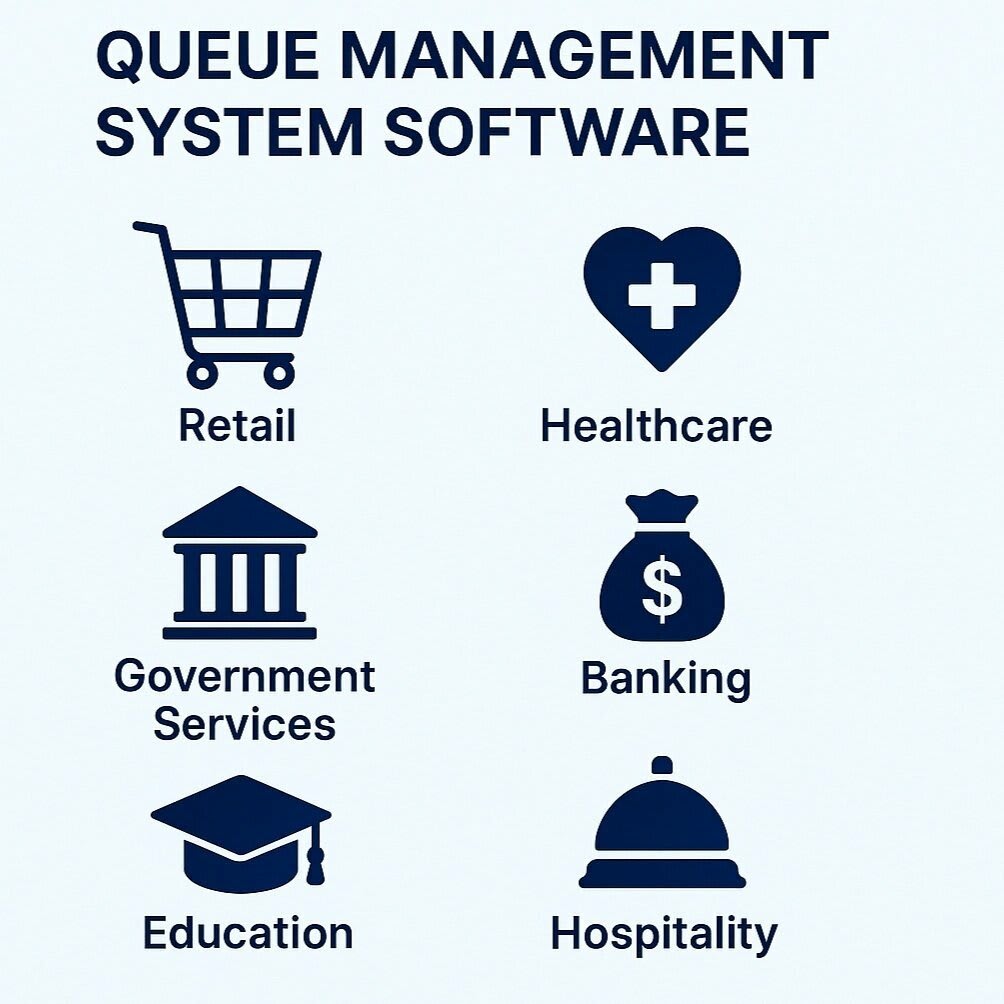
Industries That Use Queue Management System Software – QueueAway
This infographic showcases six major industries—retail, healthcare, government services, banking, education, and hospitality—that rely on queue management system software to enhance service delivery and customer satisfaction
Factors to Consider When Choosing a Queue Management System
Choosing the right queue management system (QMS) is crucial for any organization looking to enhance its customer service and operational efficiency. These systems are designed to streamline the customer flow, minimize wait times, and improve overall service delivery. When evaluating potential solutions, consider the unique queuing challenges your organization faces, the workflows in place, and the volume of customer traffic handled daily. Customization and scalability are also key factors; the system should be able to grow and adapt alongside your business. Compatibility with existing IT infrastructure ensures seamless integration, while user-friendliness for both staff and customers can significantly improve the queuing experience. Additionally, features such as real-time monitoring and detailed analytics are vital for making data-driven decisions and refining operational processes.
📊 Statistic: According to McKinsey, 75% of consumers have tried a new shopping behavior during the pandemic, and 71% plan to continue these habits, including virtual queueing and curbside pickup.
Scalability
Scalability is a foundational factor when selecting a queue management system. As businesses expand, the queue management software must accommodate increased demand across new locations seamlessly. The ideal system not only supports a growing number of users but also enhances customer flow efficiency during expansion phases. A scalable QMS reduces costs associated with resource allocation by optimizing operations as the organization grows. It should align with your company’s future growth plans and evolving service needs to facilitate efficient management of more comprehensive and complex customer interactions. This adaptability ensures that your organization maintains high efficiency and exemplary customer service, even as your business scales.
Integration Capabilities
Integration capabilities in queue management systems play a pivotal role in optimizing business operations by enhancing communication and collaboration. Advanced QMS solutions can integrate with platforms like Twilio and Salesforce, boosting their functionality considerably. In particular, government and banking sectors benefit from tools like Q-Flow, which streamline operations through seamless integrations. Solutions such as monday service enhance flexibility by allowing integrations with popular apps like Slack, Google Drive, and Jira. By enabling these connections, queue management systems can deliver omnichannel solutions, ensuring that diverse modules work in harmony for smooth business operations. This interconnected approach helps businesses offer more cohesive and responsive customer service.
Cost-Effectiveness
Cost-effectiveness is a compelling reason to implement queue management software. By automating routine tasks and reducing operational inefficiencies, businesses can streamline processes, potentially lowering costs. As businesses grow, scalable QMS solutions help minimize expenses by efficiently adapting to new demands, particularly when expanding to new locations. Enhanced customer experiences achieved through reduced wait times often lead to increased sales and a higher return on investment. Virtual queue management tools provide real-time data and analytics to optimize staffing and remove bottlenecks, creating additional cost savings. Moreover, improvements in staff performance and customer retention can diminish expenses related to customer dissatisfaction, enhancing the financial benefits of the system.
Customization and Flexibility
Customization and flexibility are key strengths of sophisticated queue management systems like Verint Queue Management. This software offers a configurable system that allows significant adjustments without requiring vendor support, thanks to its intuitive user interface. Businesses can tailor the software to include features such as click and collect or buy online, pick up in store, enhancing the queuing process to better suit their specific needs. A scalable QMS can support company growth by effectively reducing costs as new locations are added. The ideal system should empower businesses to personalize their customer service through a robust set of features, efficiently optimizing service delivery. By incorporating various service modules, a flexible queue management system ensures personalized customer interactions, significantly enhancing customer satisfaction and loyalty.
Leading Queue Management Systems in the Market
Queue management systems have become essential for businesses seeking to enhance customer service and streamline operations. Leading solutions in the market today are not just about managing physical lines but have evolved to offer a range of features that improve customer experiences and overall service delivery. These systems incorporate real-time data and analytics, virtual queuing, and self-service options to create a seamless customer journey. Key players in this space, such as Verint and Greetly, provide highly configurable solutions tailored to specific business needs. These advanced systems help reduce average wait times and optimize staff performance, ultimately working towards better customer loyalty and satisfaction.
📊 Statistic: A Salesforce survey found that 88% of customers say the experience a company provides is as important as its products or services.
Operational Benefits That Go Beyond the Frontline
Queue management isn’t just about improving the customer experience. It also delivers substantial internal benefits:
Real-time data for better decision-making
Optimized staff allocation to meet demand peaks
Reduced bottlenecks in service flow
Faster service times, reducing overall customer abandonment
📊 Statistic: Harvard Business Review reports that companies that lead in customer experience outperform their competitors by nearly 80% in terms of revenue growth.
These insights not only improve operations but enable predictive modeling, helping businesses prepare for traffic surges and make proactive improvements.
The Financial Impact of Queue Mismanagement
Time is money—and nowhere is that more evident than in poor queuing systems. Lost time leads to lost revenue and lost customers.
📊 Statistic: A study by Forrester found that long wait times can reduce customer satisfaction by up to 50%.
📊 Additionally, businesses lose up to $1.6 trillion per year globally due to customers switching providers after poor experiences (Accenture).
Queue management system software isn’t just an upgrade—it’s a high-impact investment with measurable ROI.
Poor customer service costs businesses billions annually… Forbes – Customer Experience Stats
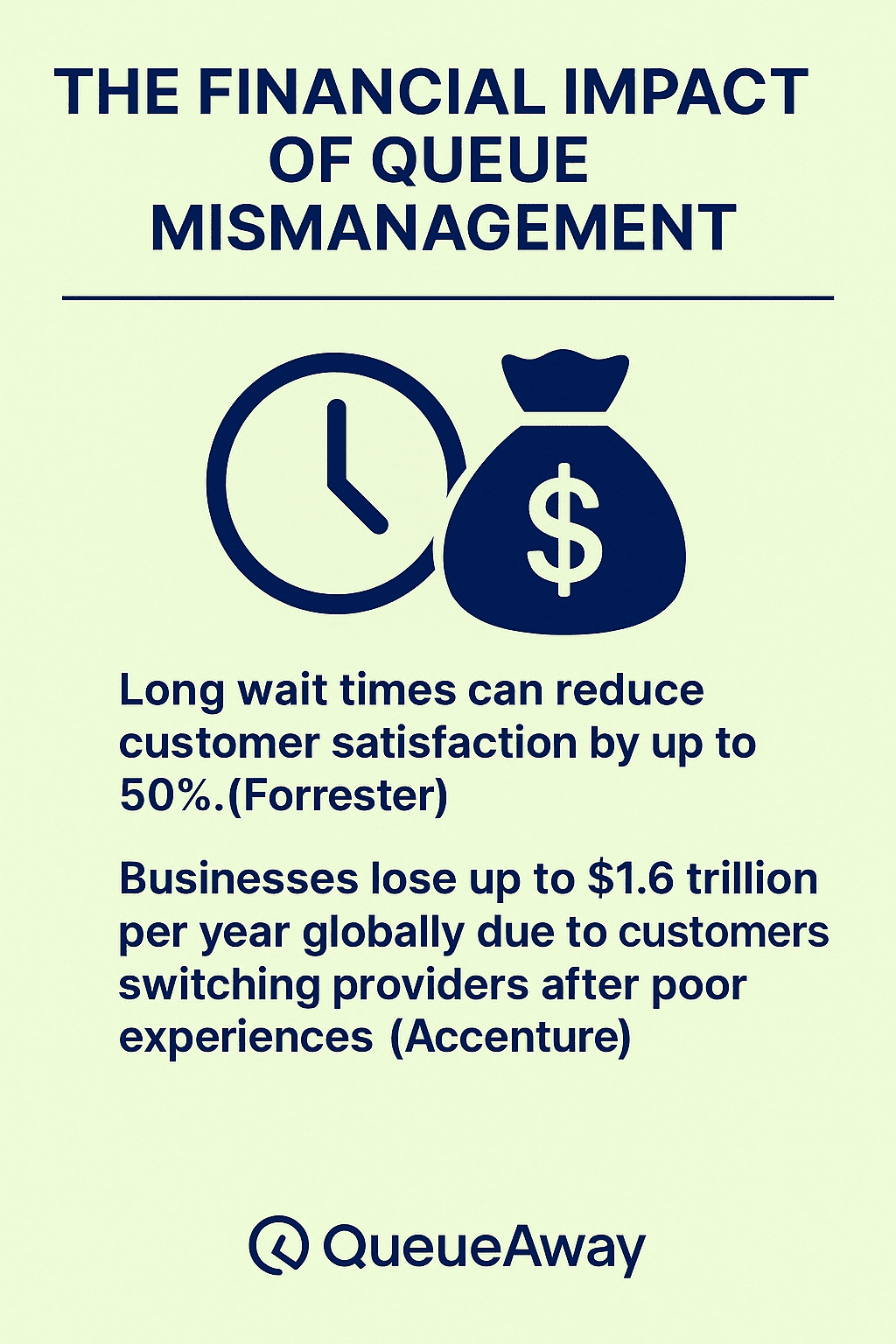
The Financial Impact of Queue Mismanagement – Queue Management System Software by QueueAway
This infographic illustrates the economic consequences of inefficient queuing—highlighting how queue management system software from QueueAway helps reduce lost revenue and boost customer satisfaction.
Core Features of Modern Queue Management Software
Not all queue management systems are created equal. The best solutions go far beyond issuing tickets or managing turn-taking—they act as intelligent platforms that optimize the full customer journey from entry to exit. In 2025, the most effective queue management system software is defined by its adaptability, integration capabilities, and data-driven approach.
Let’s break down the core features you should expect in a top-tier solution:
1. Virtual Check-In & Remote Queuing
Customers can join queues from anywhere—via mobile apps, websites, or even QR codes displayed onsite. This eliminates the need for physical lines and gives users freedom and flexibility.
📊 Statistic: A report from Retail Dive states that 56% of shoppers prefer stores offering mobile or remote queue options.
Benefits:
Eliminates overcrowding in physical spaces
Increases customer comfort
Helps staff prepare for incoming customers
2. Real-Time Queue Monitoring and Notifications
Customers are kept informed through SMS, push notifications, or digital displays. Staff receive real-time updates on queue lengths and customer progress.
📊 Statistic: According to Salesforce, companies using real-time queue data experience a 35% drop in customer complaints and a 23% improvement in service speed.
Benefits:
Decreased no-show rates
Reduced perceived wait times
Smoother service transitions
Smart Queue Routing and Prioritization
Systems can route customers based on service type, urgency, or customer profile. For example:
Prioritize emergency patients in hospitals
Direct VIP clients to dedicated queues
Send specific service requests to specialized staff
Benefits:
Tailored service for individual needs
Higher throughput without compromising quality
Efficient use of specialized staff
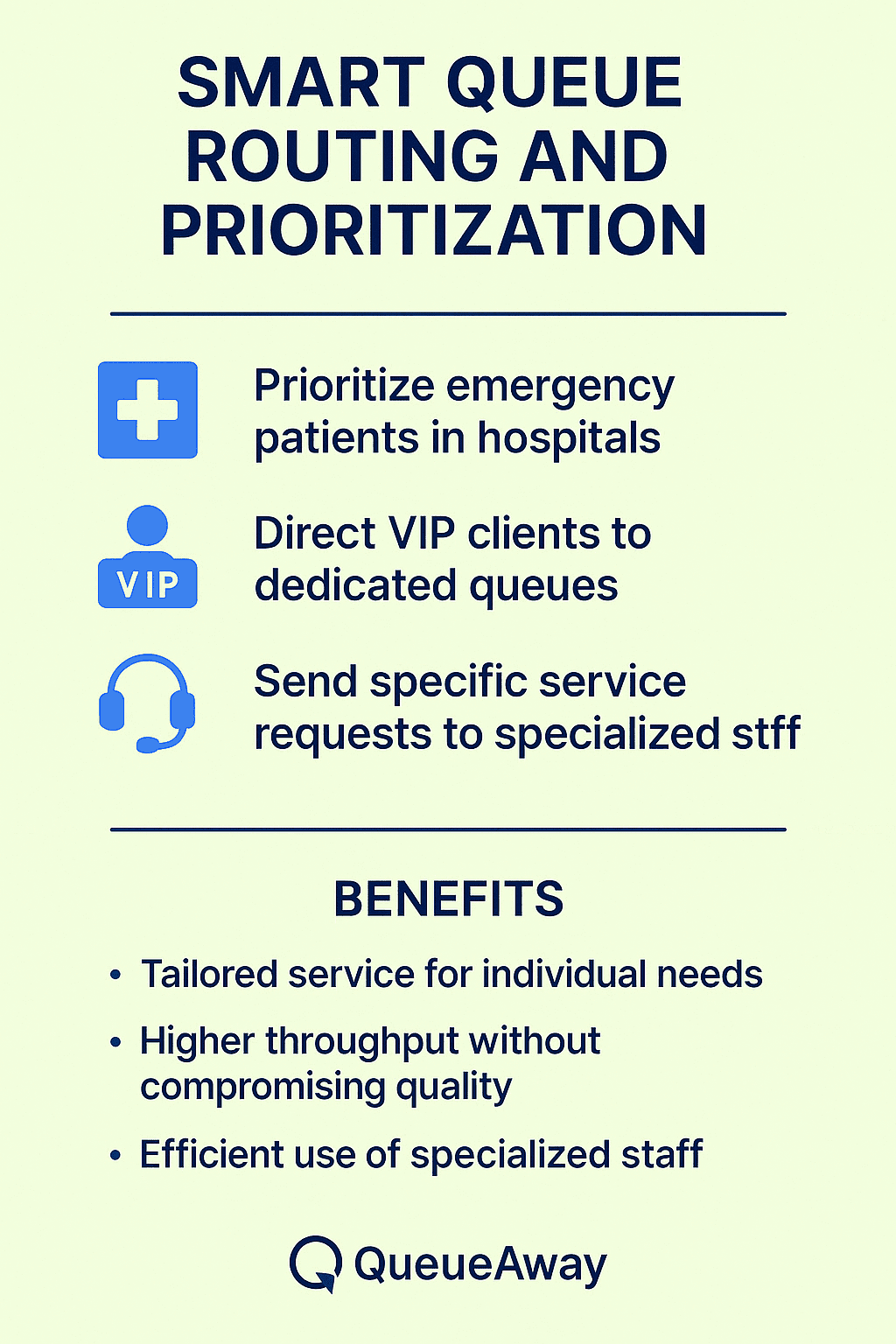
Smart Queue Routing and Prioritization – Queue Management System Software by QueueAway
This infographic illustrates how smart queue routing and prioritization improve customer flow and staff efficiency through targeted service paths and tailored prioritization using QueueAway's queue management system software.
4. Centralized Dashboard & Analytics
A strong queue management system includes a back-end dashboard where managers can view:
Wait time averages
Peak service hours
Abandonment rates
Staff performance data
📊 Statistic: Deloitte reports that 82% of executives say real-time data analytics improves their decision-making and resource management.
Benefits:
Actionable insights in real time
Better staffing and scheduling
Identifying friction points in the customer journey
5. Multichannel Integration
Modern systems integrate with:
CRM platforms (for personalized service)
POS systems (for tracking conversions)
Calendar apps (for appointments)
Mobile & email marketing tools (for customer retention)
📊 Statistic: Companies with strong omnichannel strategies retain 89% of their customers, compared to 33% for those with weak strategies (Aberdeen Group).
Benefits:
Unified view of the customer
Personalized service delivery
Higher retention and upsell opportunities
6. Touchless Kiosks and In-Store Devices
Even in physical settings, customers expect limited-touch experiences. Touchless kiosks, barcode scanners, and voice-activated check-ins are quickly becoming standard.
Benefits:
Reduces health risks
Speeds up onboarding
Minimizes user errors
7. Custom Branding and UX Control
The best queue systems allow companies to maintain full brand consistency—logos, colors, tone of voice, and UX design.
Benefits:
Better brand perception
Seamless integration with the business identity
Increased trust from customers
Together, these features help businesses not only manage queues—but transform them into a strategic advantage that drives loyalty, productivity, and growth.
Benefits of Queue Management System Software for Businesses
The value of queue management system software extends far beyond shorter wait times. It unlocks powerful benefits that can reshape customer interactions, streamline operations, and ultimately boost a company’s bottom line. Businesses that embrace digital queuing gain a competitive edge by delivering superior experiences while reducing costs.
Let’s break down the key business benefits with supporting data:
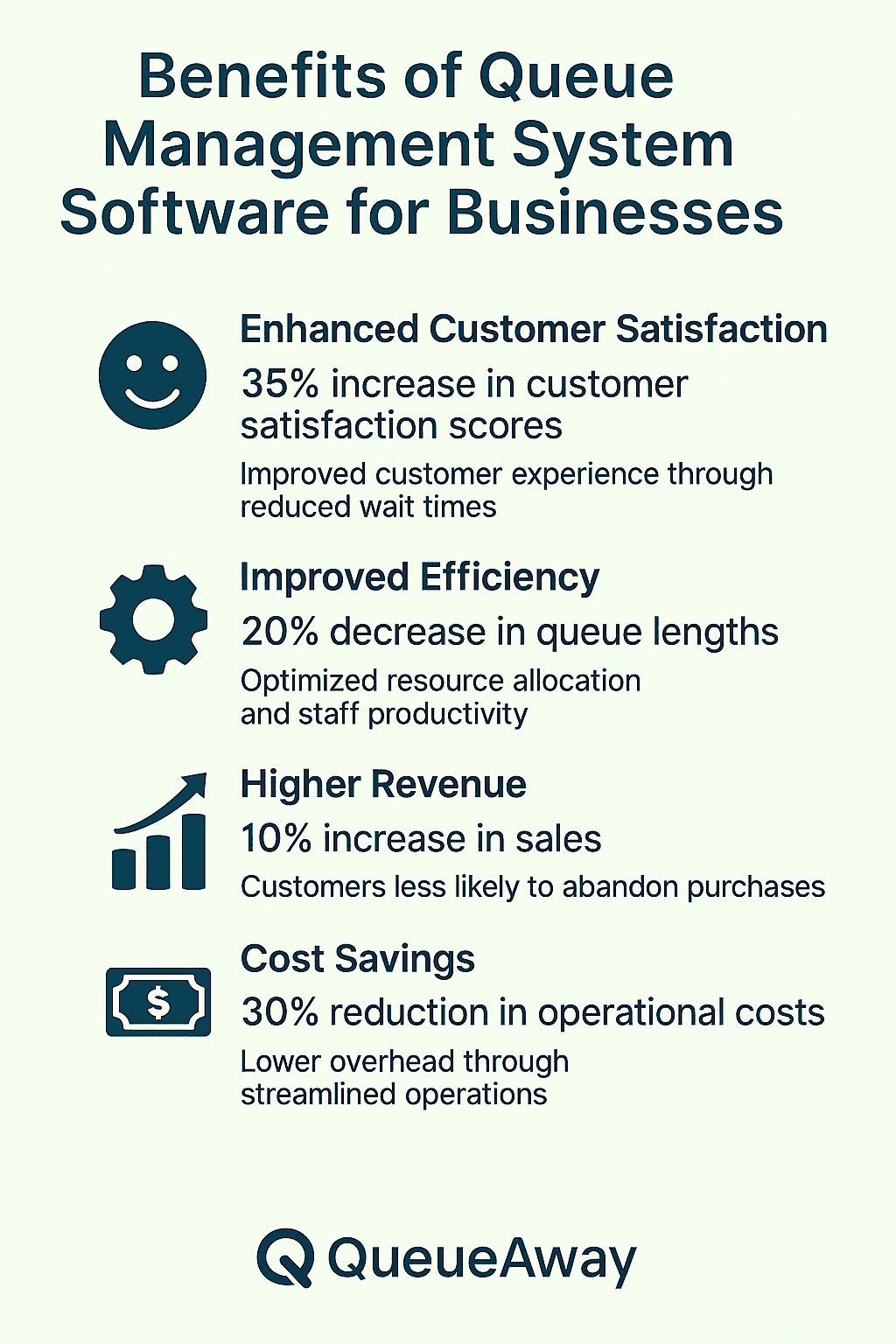
Benefits of Queue Management System Software for Businesses – QueueAway
This infographic highlights key advantages of queue management system software, including increased customer satisfaction, improved efficiency, higher revenue, and reduced operational costs—driven by QueueAway.
1. Reduced Walkouts and Abandonment Rates
Long, unmanaged wait times are a top reason customers leave before being served. Queue management software helps reduce walkouts by keeping customers informed, engaged, and in control of their waiting experience.
📊 Statistic: A study by Qmatic found that customers are 3x more likely to stay if they receive regular queue updates via SMS or app notifications.
This alone can significantly improve service throughput and increase daily transactions.
2. Improved Customer Retention and Loyalty
When customers feel respected and prioritized, they’re more likely to return. Queue transparency and reduced wait anxiety lead to a better experience—one that sets your brand apart.
📊 Statistic: According to PwC, 73% of customers say customer experience is a deciding factor in purchasing decisions.
By offering a smooth, efficient queue system, you build trust and emotional loyalty with your customers.
3. Operational Efficiency and Better Resource Allocation
With real-time data on queue volume and customer needs, managers can optimize staffing schedules, assign the right staff to the right tasks, and dynamically shift resources to meet demand.
📊 Statistic: Businesses using queue management software report a 30–45% increase in service efficiency across peak hours (source: QueueMetrics).
Benefits include:
Reduced idle time
Shorter service durations
Increased staff satisfaction due to less stress and chaos
4. Increased Revenue Through Faster Turnover
Every minute a customer waits is a minute they aren’t spending. By reducing bottlenecks, businesses can serve more people per hour, improve conversion rates, and grow revenue.
📊 Statistic: A Deloitte report found that reducing average wait times by just 5 minutes can increase sales by up to 15% in retail environments.
In restaurants, banks, and clinics, increased throughput directly correlates with higher revenue.
5. Enhanced Brand Image and Reputation
First impressions matter. An organized, modern queue system signals that a business respects its customers’ time and embraces innovation.
📊 Statistic: According to BrightLocal, 87% of consumers read online reviews about a business, and wait-time experiences are among the most common complaints.
Offering an efficient queuing system can earn higher ratings, better reviews, and more word-of-mouth referrals.
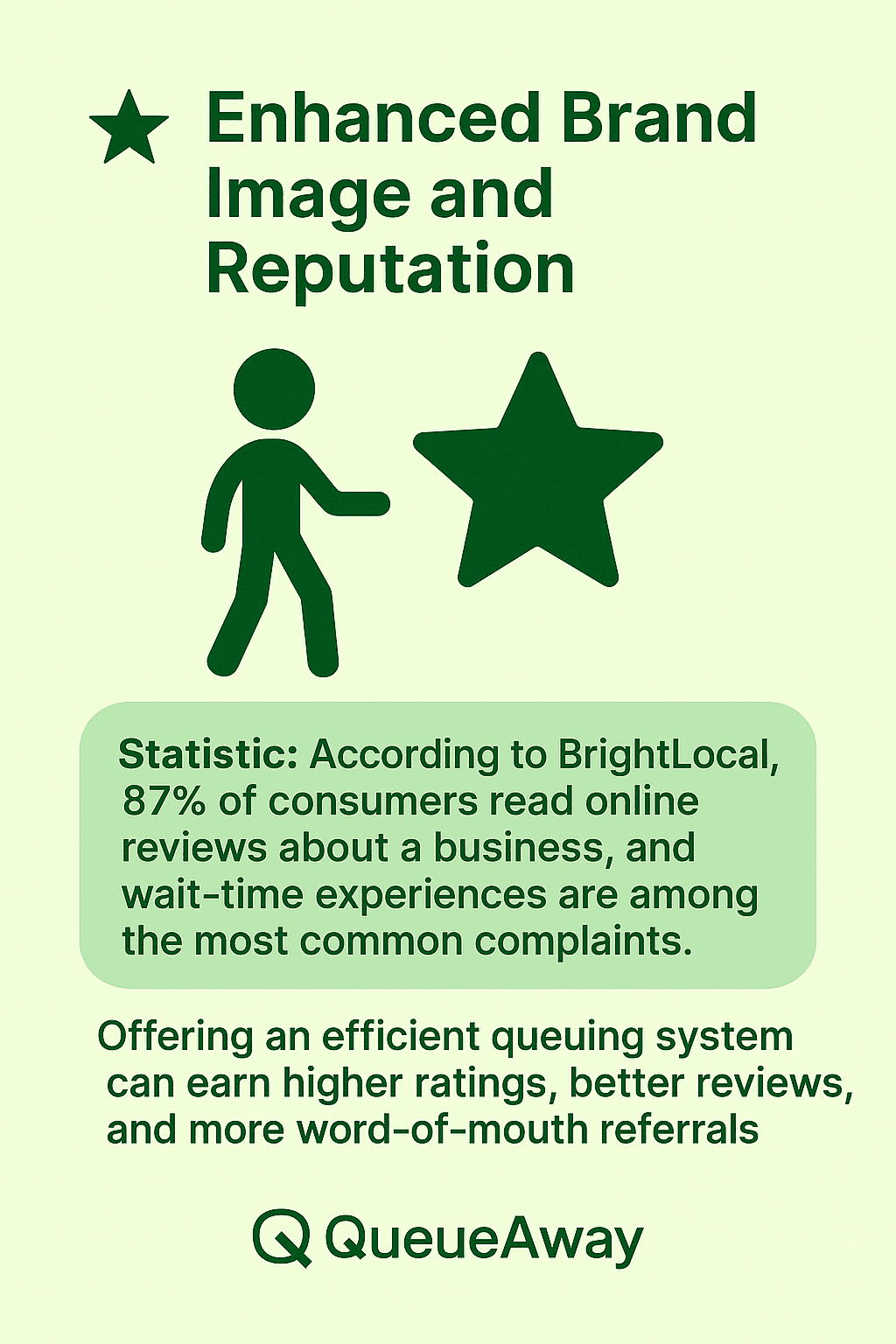
Enhanced Brand Image and Reputation with Queue Management System Software – QueueAway
This visual demonstrates how QueueAway's queue management system software strengthens brand perception by improving customer experience, leading to better reviews, higher ratings, and positive referrals.
6. Actionable Data and Business Intelligence
Queue software offers a wealth of analytics, including:
Average wait and service times
Hourly/daily footfall trends
Abandonment rates
Customer satisfaction (via post-service surveys)
This data allows for:
Continuous improvement
Smarter decision-making
Long-term cost reduction and scaling strategies
📊 Statistic: IBM reports that 62% of retailers consider data analytics critical to gaining a competitive advantage.
7. Scalability Across Locations
Whether managing one location or hundreds, queue management systems offer centralized control, ensuring consistency in customer experience.
Use case:
A bank with 150 branches can monitor performance and make location-specific improvements—while maintaining uniform service quality.
In short, queue management system software isn’t just a digital upgrade—it’s a strategic investment that strengthens both the front and back of your business.
Looking for a more strategic overview? Check out our comprehensive guide to queue management systems.
Use Cases by Industry: How Queue Management System Software Solves Real Problems
Queue management system software is not a one-size-fits-all solution—it’s a flexible, scalable tool that adapts to industry-specific challenges. Let’s take a deep dive into how different sectors are using queue software to reduce friction, improve service, and boost ROI.
Retail: Managing In-Store Traffic and Click & Collect Services
In retail, managing peak times—especially during promotions, holidays, or product launches—can be the difference between profit and chaos. Queue software improves the customer journey by organizing:
Walk-in traffic
Click & collect pickups
In-store service desks (e.g., mobile device repairs or returns)
📊 Statistic: A survey by Retail Systems found that 63% of shoppers are more likely to shop in a store that offers virtual queuing.
Real-World Example:
IKEA uses digital queue systems at its returns desk and in self-service departments, allowing customers to scan a QR code, get updates, and browse while they wait.
Healthcare: Streamlining Patient Flow
Healthcare facilities face unique challenges: critical timing, complex triage, and high stakes. Queue software helps manage:
Appointment scheduling
Walk-ins and emergency triage
Notifications for delayed services
Load balancing between doctors and departments
📊 Statistic: According to HealthIT.gov, hospitals using digital queue systems report 28% fewer patient complaints and 22% improved staff performance.
Real-World Example:
NHS Trusts in the UK have implemented queue systems in vaccination centers and outpatient clinics, reducing overcrowding and increasing patient satisfaction.
Banking: Enhancing In-Branch Experiences
In-person banking still plays a vital role—especially for complex tasks like loans, mortgages, and document verification. Queue software enables:
Appointment and walk-in integration
Priority service for business or VIP clients
Staff assignment based on service type
Performance monitoring at branch level
📊 Statistic: A study by Accenture showed that 68% of consumers are more likely to stay loyal to banks that offer flexible digital services, including queue management.
Real-World Example:
Barclays Bank uses queue software to allow clients to pre-book time slots and check-in via app, cutting average wait times by over 40%.
Hospitality: From Lobbies to Restaurants
Hotels and restaurants live or die by their guest experience. Waiting in a crowded lobby or being unsure of reservation timing can tarnish a brand.
Queue management software supports:
Touchless check-ins and room readiness alerts
Spa and facility booking systems
Restaurant waitlists with live countdowns
Concierge queueing for high-demand activities
📊 Statistic: According to HospitalityNet, hotels using digital check-in/queuing solutions report a 35% higher guest satisfaction rating than those that don’t.
Real-World Example:
Marriott properties are testing app-integrated queue tools for mobile room readiness and restaurant reservations.
Government Services: Cutting Wait Times at Scale
DMVs, visa offices, licensing bureaus—all face the challenge of high footfall and long waits. Queue management software introduces:
Appointment optimization
ID-based check-ins
Real-time updates
Multilingual interfaces
📊 Statistic: In a case study by Qmatic, a state DMV office reduced average wait times from 52 minutes to 14 minutes after deploying a queue system.
Real-World Example:
The UK Home Office uses digital queueing for passport and visa appointments, with integration into citizen ID systems for faster check-ins.
Education: Streamlining Student Services
Universities and colleges juggle multiple service points: admissions, registrar offices, financial aid, and career centers.
Queue management systems assist with:
Online booking for advisor meetings
Real-time lobby queue displays
Notifications for service availability
Campus-wide usage analytics
📊 Statistic: EDUCAUSE reports that student services using virtual queues see 23% higher satisfaction ratings than those using walk-in systems.
Real-World Example:
University College London (UCL) has implemented queue software for campus services, improving appointment flow and reducing wait-related complaints.
From frontline efficiency to back-office insights, queue management software is delivering industry-specific value on a global scale.
Choosing the Right Queue Management System Software
With so many solutions on the market, selecting the right queue management system software can be overwhelming. But the right choice can mean the difference between transformative customer experiences and missed opportunities.
Here's a guide to help you make an informed, strategic decision.
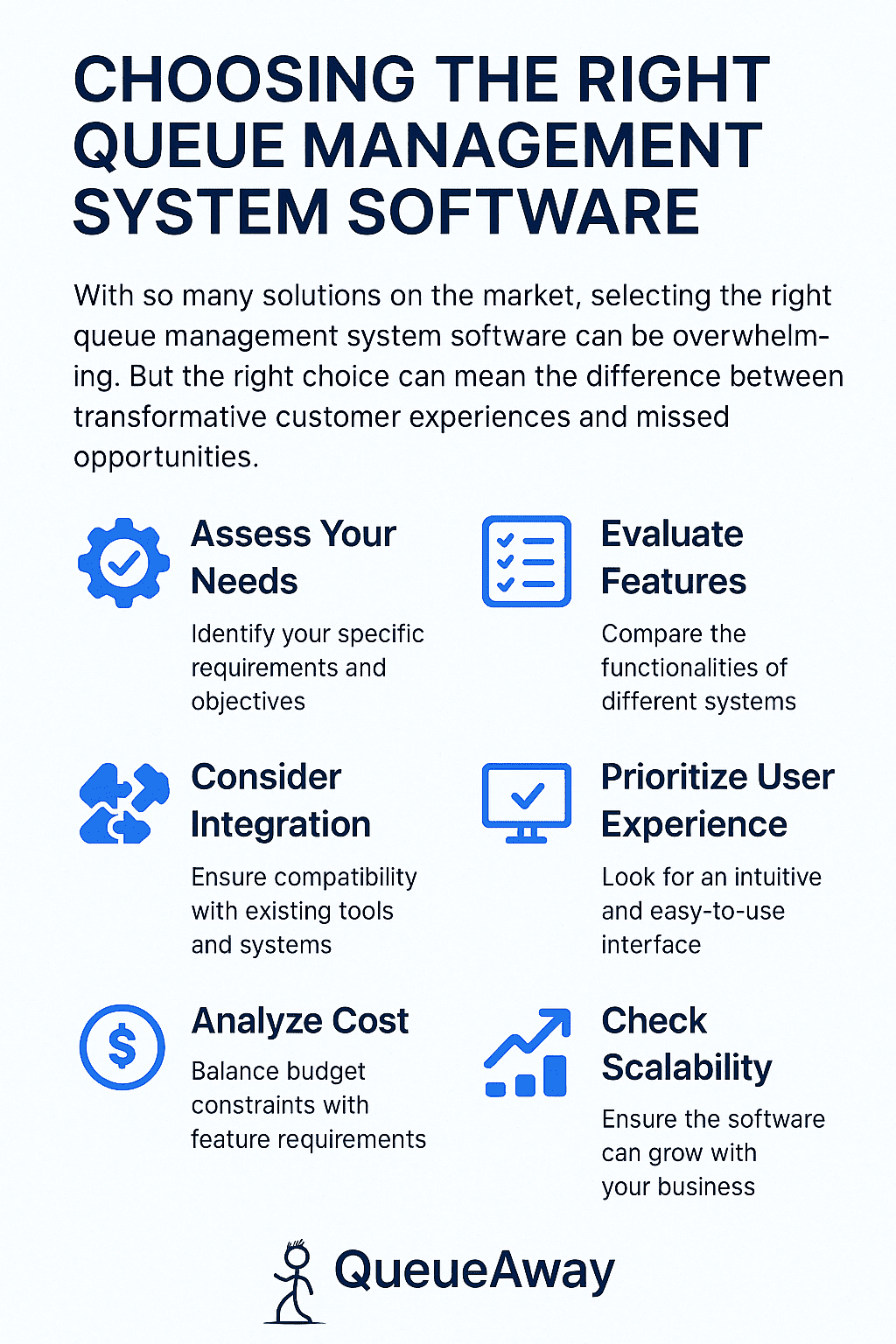
Choosing the Right Queue Management System Software – QueueAway
This infographic offers a step-by-step guide to selecting the best queue management system software, covering needs assessment, feature comparison, integration, user experience, cost analysis, and scalabilityThis infographic offers a step-by-step guide to selecting the best queue management system software, covering needs assessment, feature comparison, integration, user experience, cost analysis, and scalability.
1. Scalability and Flexibility
Your chosen solution should grow with you. Can it handle:
Multiple service points?
New branch rollouts?
Peak season demand spikes?
Look for software that works just as well for 1 location as it does for 100.
📊 Statistic: According to Software Advice, 68% of businesses regret purchasing systems that didn’t scale as expected.
2. Mobile and Remote Queueing Capabilities
Modern customers expect convenience. Mobile queuing via app, web, or SMS is now a must. Features should include:
Virtual check-ins
Live queue position tracking
Push/SMS notifications
📊 Statistic: A GSMA Intelligence report found that 83% of consumers prefer businesses that offer a mobile-first experience.
3. Real-Time Reporting and Analytics
Look for systems that provide:
Real-time monitoring dashboards
Historical performance reports
Service-level metrics
Staff efficiency tracking
These insights help you optimize staffing, identify trends, and reduce operational costs.
📊 Statistic: A report by Gartner found that companies using real-time analytics outperform peers by 20% in operational efficiency.
4. Integration with Existing Systems
Does the software integrate with:
CRM systems?
Calendar tools?
POS or payment solutions?
Marketing platforms?
Integration allows for a seamless experience across digital touchpoints and helps unify customer data.
5. Customization and Branding
Your queue experience should reflect your brand. Look for:
Customizable interfaces
White-label options
Brand-consistent notifications
This ensures your queue management system enhances your brand identity, not competes with it.
6. Security and Compliance
Security is non-negotiable—especially for healthcare, banking, and government organizations.
Ensure the software is:
GDPR-compliant (for UK/EU businesses)
HIPAA-compliant (for U.S. healthcare)
Cloud-based with data encryption
Regularly updated and audited
7. Customer Support and Onboarding
Choose vendors who offer:
Hands-on onboarding and training
24/7 customer support
Detailed documentation and video tutorials
Local language support if needed
📊 Statistic: According to Zendesk, 52% of customers will abandon a product if support is inadequate—this applies just as much to internal business tools.
Red Flags to Watch Out For
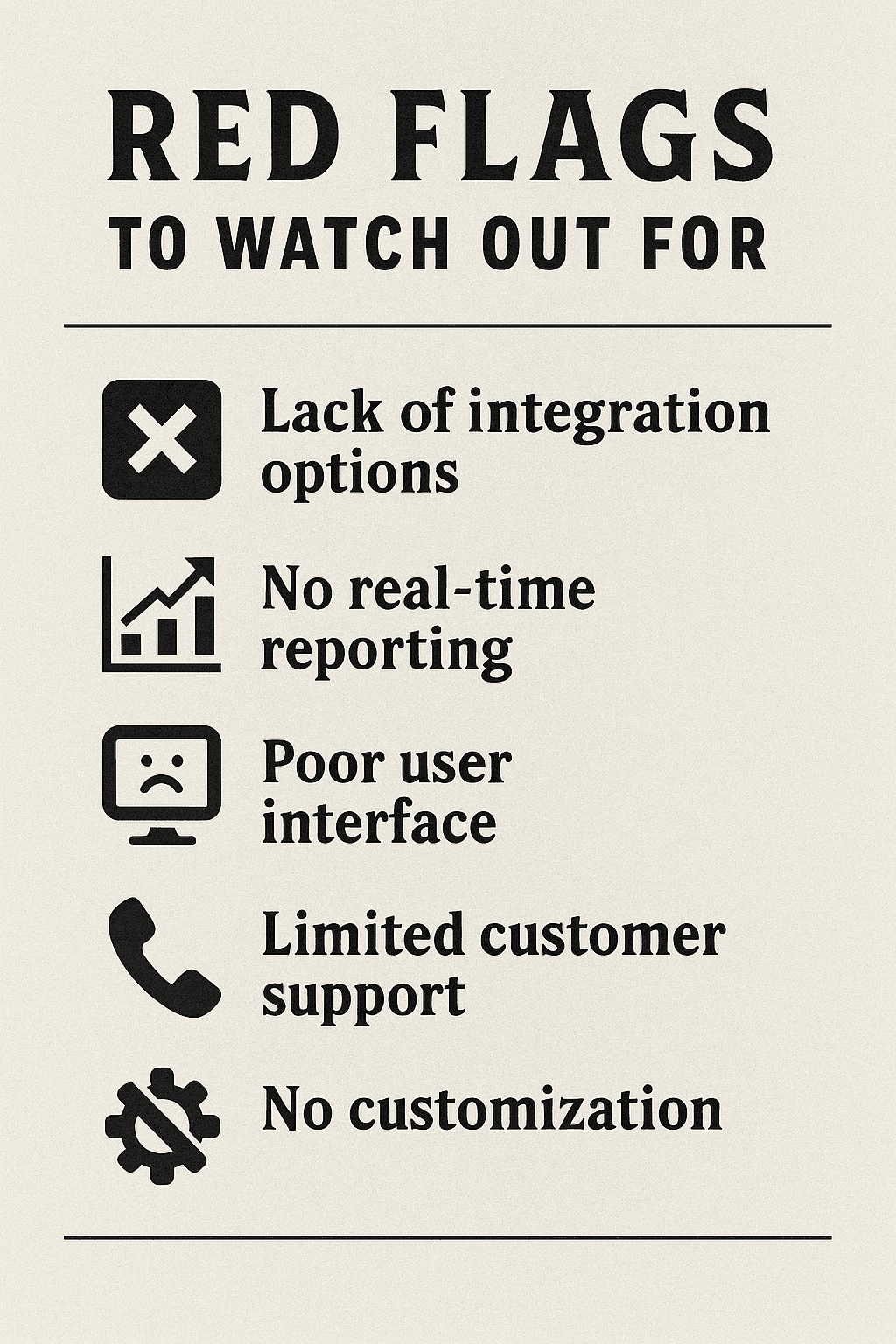
Red Flags to Watch Out for When Choosing Queue Management System Software
Highlights key warning signs to avoid when selecting queue management system software, including lack of integration, poor UI, and no real-time reporting.
Lack of mobile functionality
No real-time data or reporting
Complex or outdated user interfaces
Hidden pricing for key features
No demo or trial available
Try Before You Buy
Before committing, request:
A live demo or free trial
A reference from an existing customer
A roadmap of product updates
Investing in the right system ensures not only smoother operations—but long-term growth and happier customers.
Future Trends in Queue Management System Software
As technology continues to evolve, so does the role of queue management system software. What started as a tool to control foot traffic has become a cornerstone of smart customer experience strategy. The future points to even more intelligent, predictive, and personalized queueing systems.
Let’s explore the top trends shaping queue management in 2025 and beyond:
1. AI-Powered Queue Forecasting and Optimization
Artificial Intelligence (AI) enables queue systems to go beyond real-time reactions and start making predictive decisions:
Anticipating queue length based on historical data
Recommending optimal staffing levels
Predicting peak hours with weather, event, or footfall data
📊 Statistic: According to IBM, 60% of enterprises implementing AI in operations saw measurable improvements in efficiency and decision-making.
AI turns reactive queue management into proactive service orchestration.
AI and automation are now central to smarter queue management software… PwC – AI for customer experience
2. Omnichannel Queueing
In the age of unified customer experiences, businesses must support queue entry from:
Mobile apps
Websites
In-store kiosks
Social media links
QR codes on receipts or posters
Customers should be able to join a queue on one platform and receive updates on another without losing continuity.
📊 Statistic: Harvard Business Review notes that customers using more than one channel spend 4% more in-store and 10% more online.
3. IoT Integration and Smart Facilities
Queue software is increasingly being paired with Internet of Things (IoT) devices to monitor:
Room occupancy
Foot traffic
Environmental factors (e.g., temperature, noise)
This allows for:
Dynamic queue redistribution
Real-time space management
Triggered alerts for overcrowding or equipment status
Example: A smart building adjusts HVAC settings or room access based on queue density.
Chatbot and Voice Integration
Virtual assistants like Alexa, Google Assistant, or custom chatbots can:
Book or cancel queue entries
Provide live updates on wait times
Gather customer feedback after service
📊 Statistic: Juniper Research predicts that chatbots will handle 75–90% of customer queries by 2026, significantly reducing reliance on live staff.
This integration creates frictionless, voice-activated customer experiences.
5. Hyper-Personalization and Behavioral Insights
With the help of CRM and data integrations, queue systems can now personalize:
Greeting messages
Estimated wait times
Service agent assignments
Post-visit feedback requests
This creates a Netflix-style experience—even in a bank or clinic.
📊 Statistic: McKinsey found that personalization can boost customer engagement by 20% and conversion rates by 15%.
6. The Expanding Market
The global queue management software market is booming, driven by digital transformation and customer expectations.
📊 Statistic: According to MarketsandMarkets, the global queue management system market is projected to reach $1.3 billion by 2028, growing at a CAGR of 6.3%.
The demand for scalable, intelligent queuing tools will only increase.
The future of queue management is more than digital—it’s autonomous, integrated, and customer-first. Businesses that adopt these trends will be better positioned to lead in both service delivery and operational agility.
Conclusion: Future-Proof Your Business with Queue Management System Software
In today’s hyper-competitive, experience-driven economy, waiting in line is no longer just an inconvenience—it’s a barrier to growth. From retail floors and hospital waiting rooms to university admin desks and bank branches, inefficient queues can bleed revenue, frustrate customers, and tarnish reputations.
We’ve seen how queue management system software:
Improves customer retention
Increases revenue through faster service turnover
Enhances brand perception
Reduces operational chaos
Provides invaluable business intelligence
And as we look ahead to a future powered by AI, IoT, omnichannel personalization, and mobile-first engagement, the right queue management solution isn’t just a tech upgrade—it’s a strategic imperative.
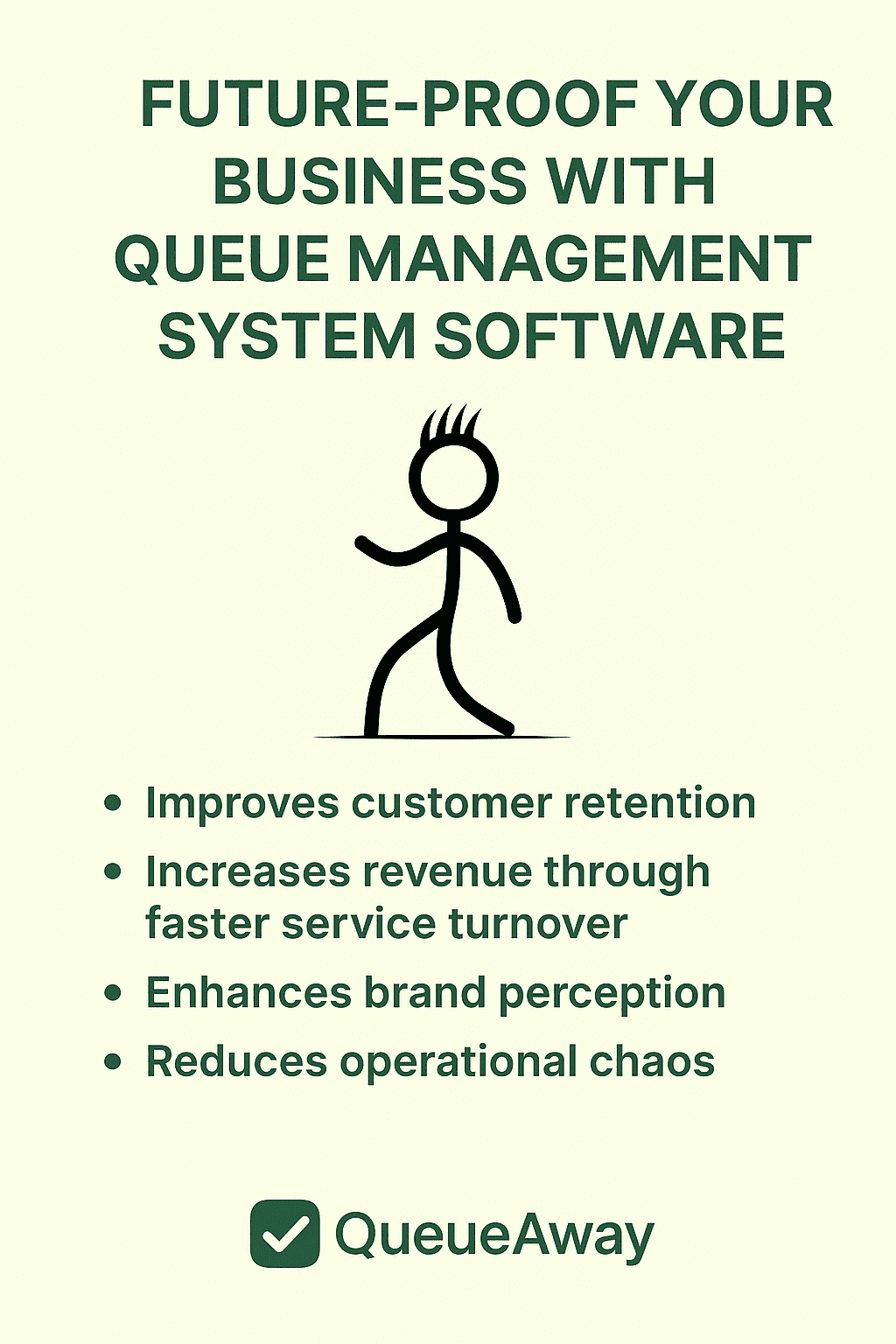
Future-Proof Your Business with Queue Management System Software – QueueAway
This visual summarizes why queue management system software is essential for modern businesses, emphasizing retention, revenue growth, operational control, and brand reputation—powered by QueueAway.
Why Choose QueueAway?
If you're serious about transforming your customer experience, QueueAway is built to deliver.
QueueAway is a cutting-edge, cloud-based queue management system software that empowers businesses of all sizes to:
Eliminate long physical queues with smart virtual check-ins
Offer real-time wait time updates and SMS/app notifications
Gain deep insights with analytics and performance dashboards
Optimize staff allocation with dynamic routing tools
Seamlessly integrate with your CRM, POS, and marketing platforms
Deliver a fully branded, mobile-first customer journey
Whether you're managing a single location or scaling across 100+ sites, QueueAway adapts to your needs—without the complexity or hidden costs.
📊 Bonus Insight: Businesses that implemented QueueAway report a 40% reduction in walkouts, 25% improvement in service speed, and higher customer satisfaction scores within the first 90 days.
Ready to Upgrade?
Start your free trial of QueueAway today and see how effortless queue management can be.
🔗 Visit www.queueaway.co.uk to get started or book a demo with our team.
Link-Worthy Takeaways for Your Site
If you're a writer, CX strategist, tech blogger, or B2B reviewer, feel free to reference this post. Here are a few backlinkable stats and facts:
The queue management system market is projected to reach $1.3B by 2028
Digital queuing reduces customer complaints by 35%
AI-powered queue routing increases service efficiency by 30%+
Mobile queuing improves customer retention and spending behavior
💬 Got questions? Looking for a customized queue solution?
Contact us at info@queueaway.co.uk — we’d love to help you streamline your service flow.


